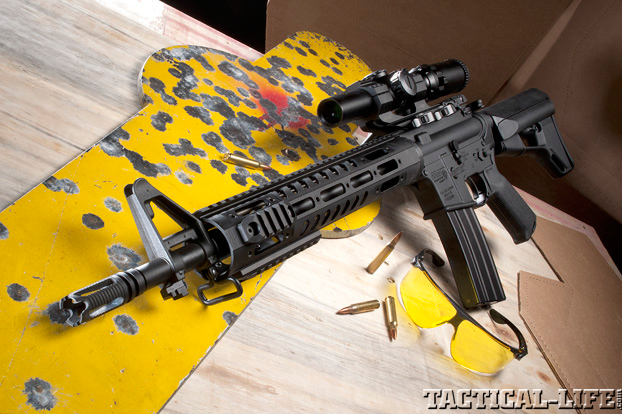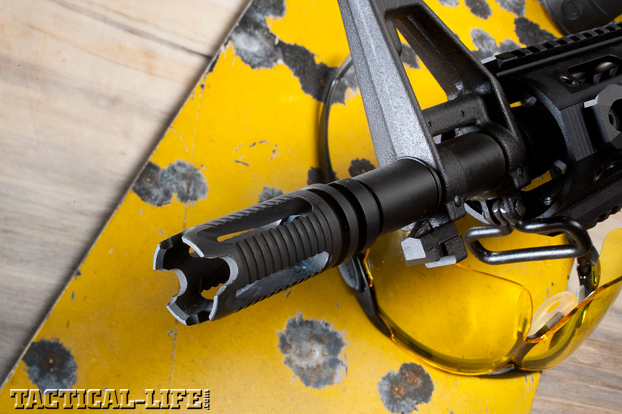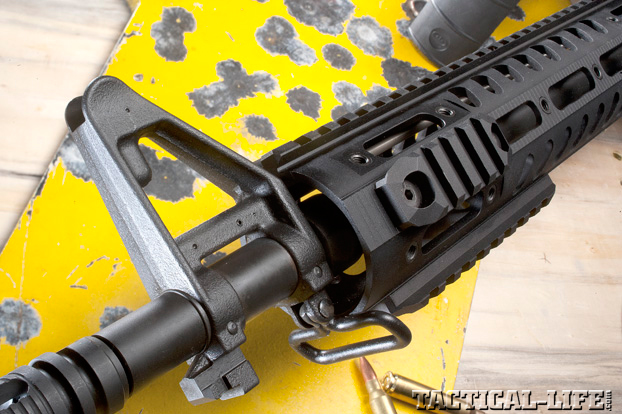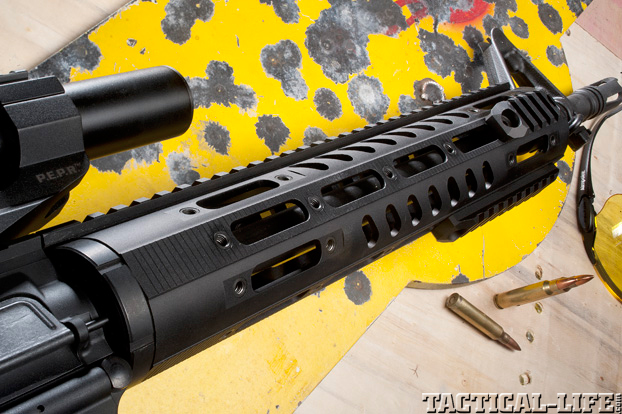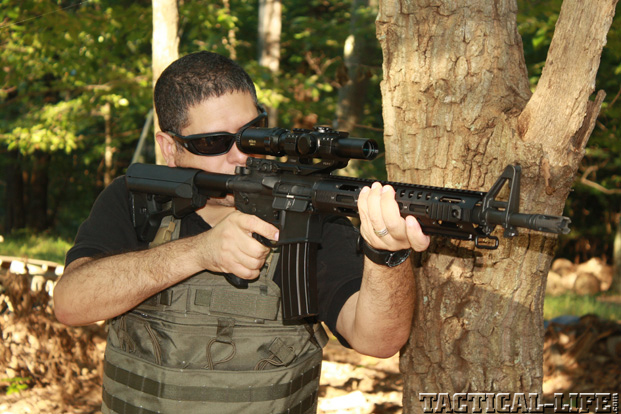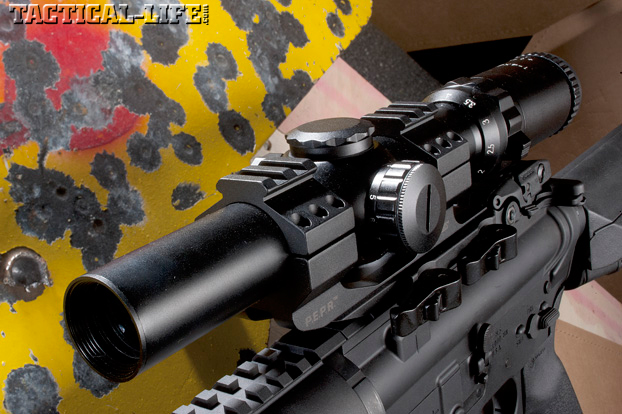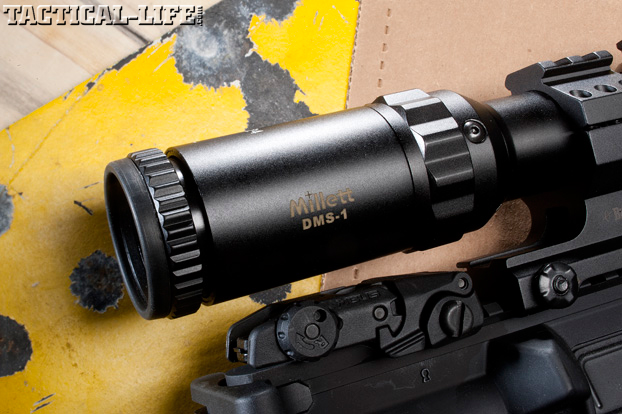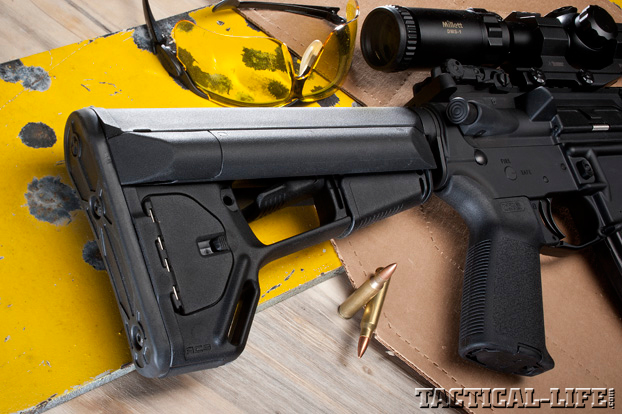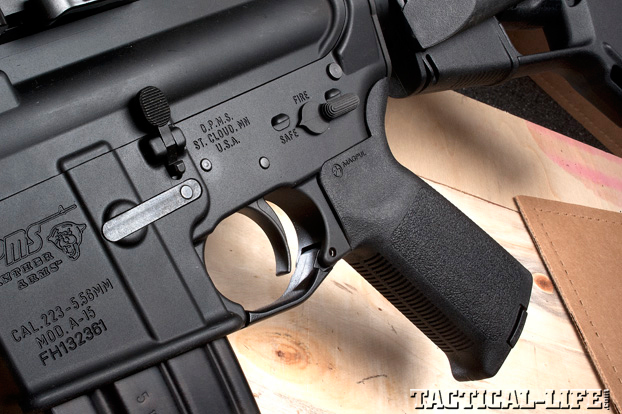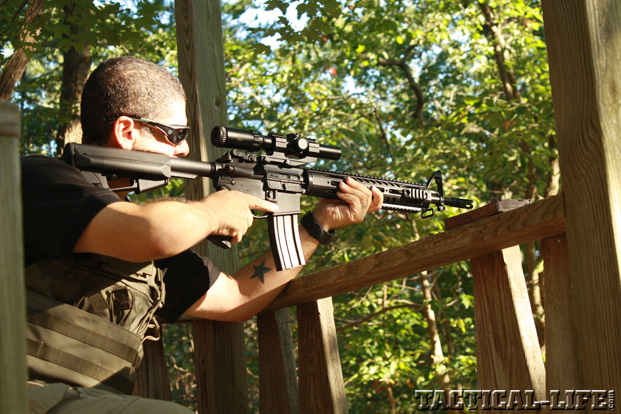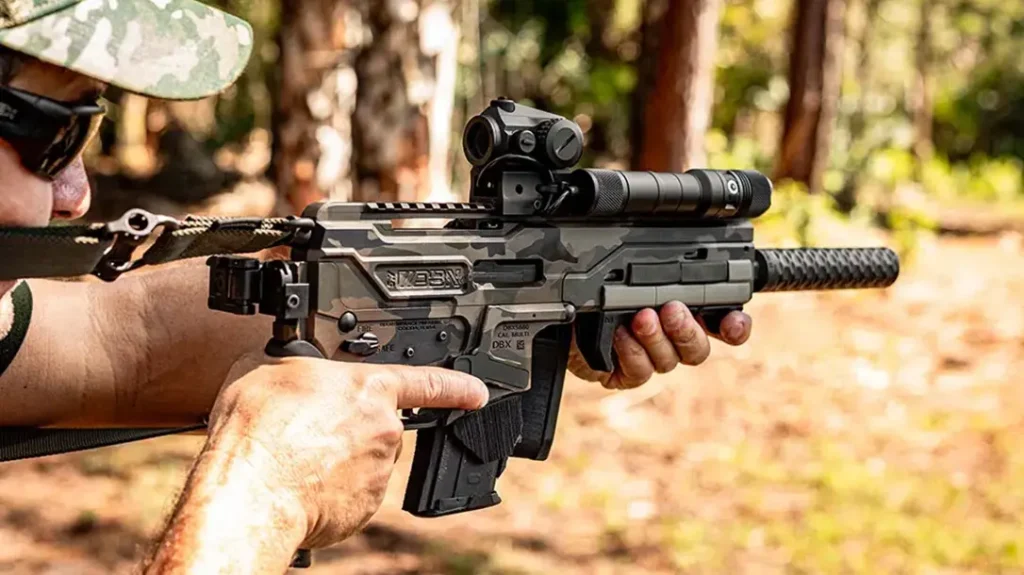DPMS, also known as Panther Arms, has been in the AR business for a long time. The company started out making M16 and AR parts for the military and commercial markets in 1986, and has been continuously expanding and improving their offerings ever since. In fact, DPMS, which is located in St. Cloud, Minnesota, is the second-largest manufacturer of AR rifles in the U.S.
With the huge and growing interest in AR rifles among competitors, hunters and recreational shooters, DPMS offers an incredibly varied catalog of options to satisfy most every AR-related desire. In the competition/tactical/recreation category, they recently introduced the DPMS TAC2 carbine, which offers many unique and welcome features.
DPMS TAC2 At A Glance
The all-new DPMS TAC2 is a semi-automatic AR-platform carbine chambered for 5.56mm NATO. It operates with a traditional direct gas impingement system. It is this gas system that represents the DPMS TAC2’s most distinct feature: unlike most carbines rifles, the DPMS TAC2 has a rifle-length gas system which places the front of the gas tube only about 3 inches from the muzzle of the 16-inch barrel.
Advertisement — Continue Reading Below
As the bullet passes the gas hole, excess gasses are diverted back down the gas tube to put pressure on the gas key and operate the bolt, thus cycling the action. Too little gas, and the action will not cycle properly, resulting in short-stroking and misfeeds or failures to eject. Too much gas, and the recoil signature is increased, and you end up with more fouling and heat in the receiver and more wear and tear on the internal parts.
The longer that the bullet is in the barrel after the bullet passes the gas hole, the more gas that is getting pushed back through the gas tube and back into the gas key. This is called dwell time. By lengthening the gas system and shortening the barrel, the dwell time is much shorter—reduced to the point that the recoil signature is a much softer push—though still properly and sufficiently timed to reliably operate the firearm. Less recoil means it is easier to keep the rifle on target for faster followup shots, which can be important in competition and tactical situations.
This rifle-length gas system is surrounded by the new DPMS M111 modular handguard system. This one-piece aluminum handguard is free-floated so that there is no contact with the barrel and features a full length of Picatinny rail on top that meets up with the flattop upper receiver for more than 18 inches of uninterrupted rail. This much rail space makes for the easy installation of more advanced optics, including night vision and thermal extenders, as well as top-mounted laser units.
Advertisement — Continue Reading Below
The modular handguard has a rounded and fairly smooth profile for comfort and provides multiple rail-attachment locations at 45-degree angles all around, making it a simple matter to add rail extensions where the operator needs them while leaving the rest of the handguard bare. It also comes standard with one 4-inch rail section underneath and two shorter rails at the 6 and 9 o’clock positions for mounting lights, lasers, a bipod and so forth.
Accuracy Enhancements
A free-floated handguard that avoids contact with the barrel helps improve accuracy, since it prevents applying any uneven stress to the barrel. The barrel itself is made from 4150 steel, which has slightly less carbon content than mil-spec barrels but retains significant durability and corrosion resistance. This 16-inch barrel is chrome-lined and features a lightweight contour throughout, which is still significantly heavier than a pencil barrel and somewhat smaller than an AR bull barrel.
The DPMS TAC2 barrel also has a 1-in-9-inch twist rate. This rifling allows the barrel to stabilize a wider range of bullet weights, including very low-weight expanding ammunition. This twist rate will also adequately stabilize heavier bullet weights, although for the heaviest .223 ammunition some will prefer a faster twist rate, such as 1-in-7 or 1-in-8.
Advertisement — Continue Reading Below
The barrel is topped off with a very distinctive Panther flash suppressor, which significantly reduces muzzle flash to preserve night vision. This steel muzzle device has a mil-spec phosphate finish and features four long ports and an aggressively scalloped front with some sharp edges. These can be effective as a standoff device in close-quarters situations.
Internally, the rear of the barrel extension features M4 feed ramps, which are cut wider and lower than those found on a standard AR rifle and are designed to improve reliable feeding of rounds from the magazine into the chamber. This can be especially important in carbines and under less-than-ideal conditions where dirt, grime and moisture can be introduced.
More Panther Particulars
The bolt and bolt carrier are both phosphated and chrome-lined, and the bolt carrier has a standard commercial contour. The gas carrier key has also been properly staked, which helps to ensure that the gas key does not become loose under fire. All manufacturers will stake their gas keys in some way, but a sure sign of quality is a properly staked gas key that shows a hammer and punch had been used with enough force to move sufficient metal into the carrier key screws.
Advertisement — Continue Reading Below
Both the upper and lower receiver are manufactured from forged 7075 T6 aluminum and feature a well-applied black hardcoat anodized finish. The controls on both the upper and lower receivers—dust cover, forward assist, bolt release, magazine release, charging handle, safety selector—are all located in the familiar places. None are ambidextrous.
The finish is excellent and has a smooth, almost satin texture. The lower receiver also features very nice and deep engraving, and the fire and safe settings are marked on both sides of the receiver. The safety selector also features a distinct tab on the right side of the rifle so the user can visually ensure if the rifle is in the fire or safe position. The left side of the lower receiver also carries the distinct DPMS snarling-panther logo.
DPMS has significantly upgraded the usual mil-spec furniture by adding the Magpul MOE polymer grip. This grip is wider than the standard grip and includes a palm swell for the web of the hand that places the hand lower on the receiver and directly in line with the trigger. It also features internal storage space for extra batteries or spare parts and has an aggressive texturing for a better, more ergonomic grip in inclement conditions.
Advertisement — Continue Reading Below
The buttstock has also been upgraded with a six-position, collapsible Magpul ACS stock. The ACS allows for easy length-of-pull adjustments for a variety of shooters or for those wearing heavy clothing or body armor. The stock’s frame design with the position lock prevents unintentional adjustments of the user’s length setting, and the stock has a significant amount of internal storage space.
The ACS stock also has a reversible, quick-detach sling-attachment point and a rubber buttpad for much more secure shoulder engagement. There is also a standard sling-attachment point, and the stock has extended cheekwelds on both sides, which provide internal storage space and increase comfort.
Other Magpul upgrades on the DPMS TAC2 include the polymer extended triggerguard, which is significantly more comfortable than the standard triggerguard and enlarges the triggerguard area for easier use with gloves. The rear sight is a Magpul MBUIS folding sight, which is windage-adjustable, deploys quickly and folds away. It provides a good sight picture, though I personally prefer a larger aperture. The front sight is of the standard AR variety, adjustable for elevation.
Advertisement — Continue Reading Below
Another of the main advantages of using a rifle-length gas system on the DPMS TAC2 is that is maximizes the distance between the rear and front sight, providing the shooter a longer sight radius. This makes accurate shooting easier.
Behind The Panther
The DPMS TAC2 has a standard mil-spec single-stage trigger, which broke at just over 6 pounds with a fair amount of creep but was actually better than most AR triggers. My own preference is for a lighter and crisper trigger, like the many drop-in models available from aftermarket manufacturers like Timney or Geissele.
On the range the rifle performed admirably, with not a single malfunction over several days of shooting and with no maintenance performed between sessions. The rifle is a bit longer than the most compact carbine because of the Panther flash suppressor and ACS stock. At 8.5 pounds empty, it is also a bit on the heavy side for a carbine, which is likely due to the full-length gas system and handguard. Still, it felt very well balanced and handled easily.
Advertisement — Continue Reading Below
The extra weight and shorter dwell time noticeably reduced the perceived recoil. The 5.56mm cartridge doesn’t normally have a lot of recoil, but even with less-than-usual recoil, staying on target was easier and shooting the rifle was a joy. For my initial range session, I mounted a Millett DMS designated marksman tactical scope—ideal for engaging targets at distances out to 500 yards as well as in CQB situations with a red-dot illuminated reticle and variable 1-4x. The scope proved to be extremely handy and provided very fast target acquisition during offhand shooting drills.
For accuracy testing I used a benchrest at 100 yards and mounted the Trijicon TR20-2 AccuPoint scope with 3-9x40mm power and a mil-dot crosshair reticle with an amber dot. The final results were between 1 and 2 MOA—quite good for this type of rifle. My best group using Black Hill 60-grain V-Max measured 1.24 inches.
I have had the opportunity to shoot many DPMS rifles over the years and, most recently, at the Outbreak Omega zombie-shooting event in Minnesota that the company organizes each year. I am continually impressed with their consistent quality, innovation and commitment to their customers. The DPMS TAC2 is sure to please and delivers all that is promised. For more information, please visit dpmsinc.com or call 800-578-3767.
Advertisement — Continue Reading Below
